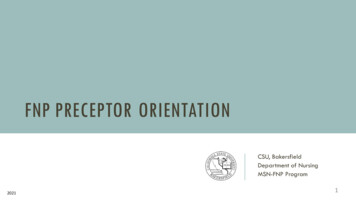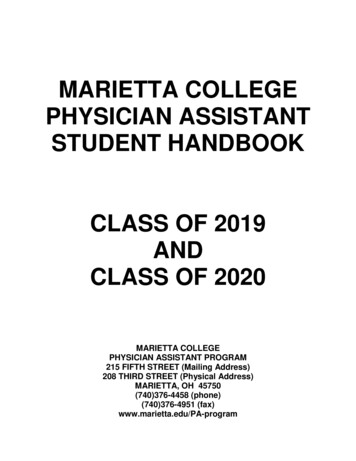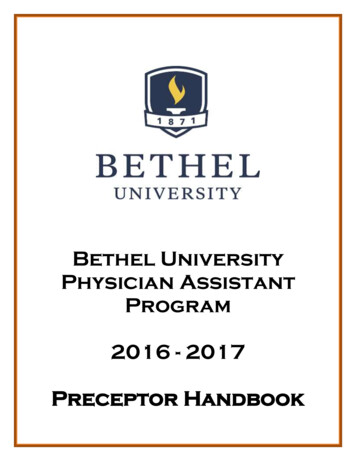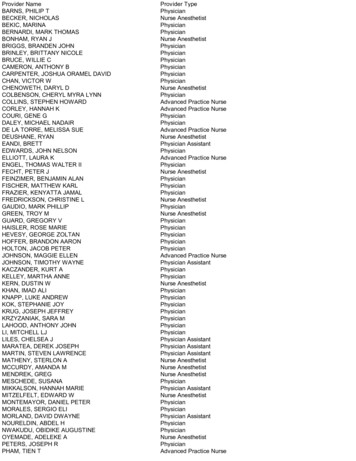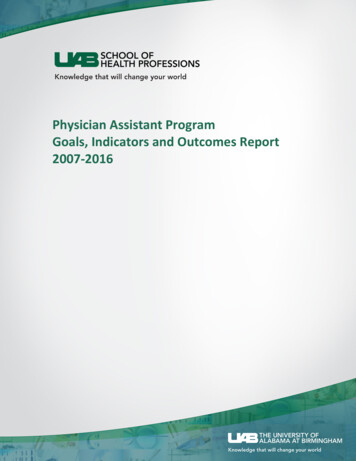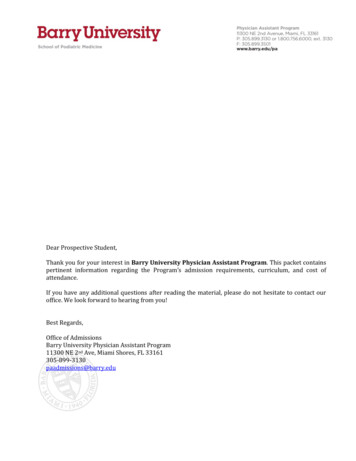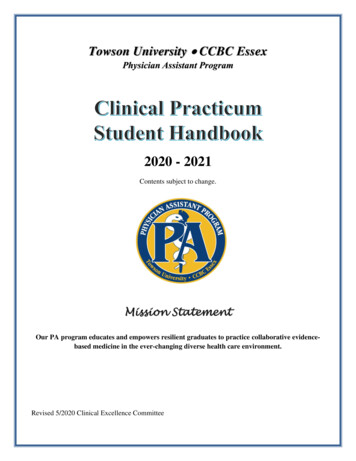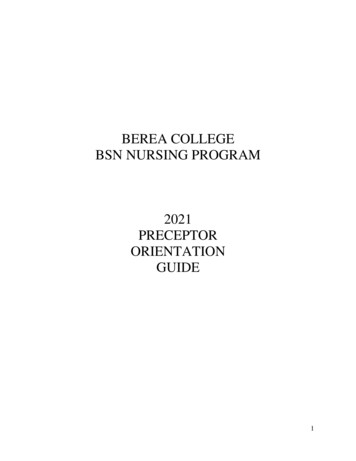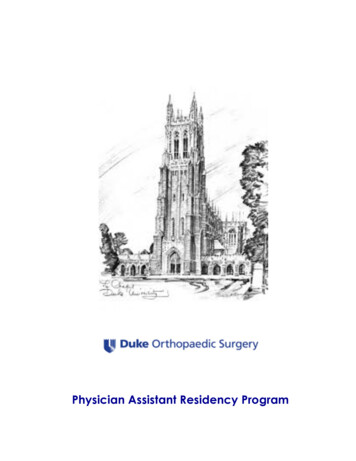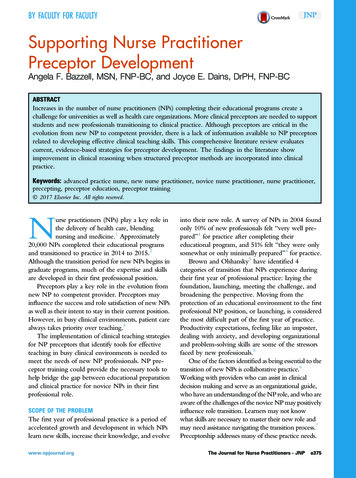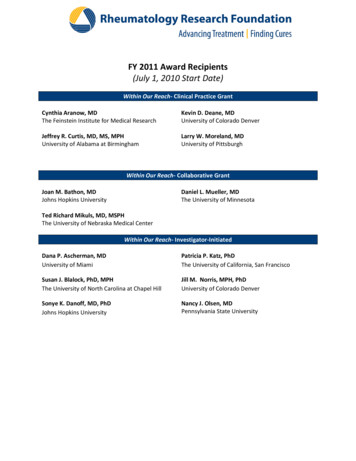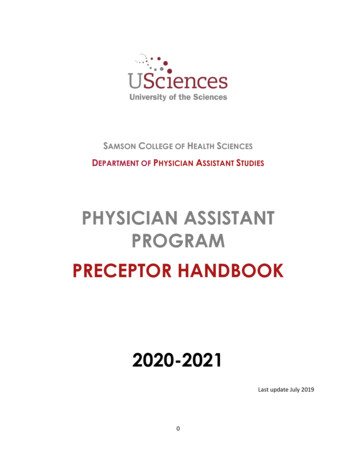
Transcription
SAMSON COLLEGE OF HEALTH SCIENCESDEPARTMENT OF PHYSICIAN ASSISTANT STUDIESPHYSICIAN ASSISTANTPROGRAMPRECEPTOR HANDBOOK2020-2021Last update July 20190
Samson College of Health SciencesDepartment of Physician Assistant StudiesTABLE OF CONTENTSIntroduction and Message to Our Preceptors .2Mission Statement .3Program Goals & Student Learning Objectiives .3Goals of the Clinical Year .3The Preceptor .4Responsibilites of the supervising preceptor .Error! Bookmark not defined.Preceptor Responsibilities .Error! Bookmark not defined.The Student .5Documentation .5Prescription writting.5Procedures .5Student Responsibilities .6Expected Progression of PA student .6Program Responsibilities .7Site Visits .7Student Evaluation.7Preceptor Resources .9Forms . 12Preceptor Application. 131600 S. 43RD STREET PHILADELPHIA, PA 19104 PAPROGRAM@USCIENCES.EDU PHONE: 215-596-7140 FAX: 215-596-7147
Samson College of Health SciencesDepartment of Physician Assistant StudiesINTRODUCTIONThe University of the Sciences Physician Assistant Program would like to thank you for participating inthe education of our students. The commitment you are offering them to create future physicianassistants is commendable. These are experiences the students will value throughout their careers. Theclinical setting is where synthesis of concepts and application of principles for quality healthcareexperiences occur. You are the key to successful learning experiences. The Physician Assistant studentwill work closely with you and learn from your example, advice and knowledge. Through yoursupervision, the student will be able to disseminate the knowledge obtained in the classroom to developskills and clinical judgment that is necessary to become a Physician Assistant.This preceptor handbook is designed to provide information about the University of the SciencesPhysician Assistant Program and to offer guidance and educational objectives for supervising andevaluating students on their clinical rotations.In addition to this handbook, you will be provided with a Syllabus along with copies of the StudentEvaluation forms as a reference for you to guide the students’ progressOur 6-semester graduate physician assistant program, leading to a Master of Science in PhysicianAssistant Studies (MSPAS) degree. The program encompasses a 3-semester didactic phase (12 months)and a 3-semester clinical phase (12 months). All students must successfully complete both phases of theprogram, regardless of previous educational/professional background.The Physician Assistant Program is a comprehensive curriculum that is completed in a consecutivemanner with the focus on primary care but prepares our graduates to practice in a wide variety ofclinical settings.The first three semesters of study consist of basic sciences and clinically related didactic courses. Alldidactic courses are required and must be successfully completed before progressing to the clinicalphase.During the clinical rotations, students are to be supervised by licensed practitioners (MD, DO, PA, NP)and will actively participate in patient assessments, perform common laboratory procedures, interpretcommon diagnostic examinations and help manage common medical problems. The work hours are setby the preceptor and can include evening and weekend hours. Students are required to work aminimum of 40 hours per week; however, many rotation sites require students to work substantiallymore hour per week.2600 S. 43RD STREET PHILADELPHIA, PA 19104 PAPROGRAM@USCIENCES.EDU PHONE: 215-596-7140 FAX: 215-596-7147
Samson College of Health SciencesDepartment of Physician Assistant StudiesMission StatementThe Mission of the University of the Sciences Physician Assistant Program is to educate future physicianassistants with a foundation in primary care, with a focus on interprofessional health care and exposureto underserved and diverse populations.Program Goals and Student Learning OutcomesThe PA Program has published a Student Handbook and Clinical Handbook for our students whichincludes our program goals and student learning outcomes. They can be viewed via the following ant-studies-mspas/clinical-handbook.pdfGoals for the Clinical YearThe PA student, upon successful completion of the didactic year will participate in 9 clinical rotations in5-week blocks.1. Family Medicine I6. Internal Medicine2. Family Medicine II7. Emergency Medicine3. Pediatrics8. General Surgery4. Women’s Health9. Elective5. Behavioral/Mental HealthThe clinical year is designed for students to gain hands-on experience through supervised, direct andmeaningful patient care. The main goals of the clinical year include:Apply clinical knowledge to patient careComplete a directed history and physical examPractice oral presentations and formulate an assessment and planPerform clinical proceduresImprove critical thinking skillsEncounter patients from diverse populationsDevelop an understanding for the healthcare system and work as part of a healthcare team3600 S. 43RD STREET PHILADELPHIA, PA 19104 PAPROGRAM@USCIENCES.EDU PHONE: 215-596-7140 FAX: 215-596-7147
Samson College of Health SciencesDepartment of Physician Assistant StudiesExpand on fund of medical knowledgeGeneral Guidelines Students have NO legal standing, and therefore, work entirely under the preceptor’ssupervisionLearning is best achieved by student participation under guidanceLearning by “trial and error” without supervision is unacceptable as it jeopardizes patientcare and threatens all professionals (nurses, administrators, other technical workers andphysicians)Students must not substitute for clinical or administrative staff during supervised clinicalpractical experiences.Learning “Under Supervision” is defined in the following manner: Eliciting a meaningful history – the preceptor is in the hospital or office suiteDoing a physical examination –the preceptor is in the hospital or officeProgress notes – dependent upon the policies of the individual clinical sitesChart orders of any kind – written by the student after discussion with the preceptor andsigned by preceptorTechnical procedures – the appropriate professional will be at the student’s side or withinimmediate proximityTHE PRECEPTORThe student is assigned a primary preceptor, who provides a clinical environment for the student’straining. The preceptor may be a licensed MD, DO, PA, NP who agrees to assume the responsibilities ofinstruction during the assigned rotation. The primary preceptor must be in good standing with theirlicensing board. Students may be given an assignment or may spend time with ancillary staff (x-ray, lab,physical therapy, etc.), as these experiences can be very valuable.Responsibilities of the supervising preceptor Formulate with the student basic goals and expectations such as:o Schedule and hourso Attendance of educational activitieso Documentation and presentationo Degree to which student will participate in care of the patientsWork with the student to improve oral presentationsIndicate clearly to the medical staff, the administration, and nursing/office staff whichpractitioner will be responsible for the activities of the student.Respond to questions as to the scope of the activities of the student.Provide the student with an orientation to the site including a review of the site schedule,policies, and procedures.4600 S. 43RD STREET PHILADELPHIA, PA 19104 PAPROGRAM@USCIENCES.EDU PHONE: 215-596-7140 FAX: 215-596-7147
Samson College of Health SciencesDepartment of Physician Assistant Studies Assist student in meeting the assigned objectives for the specific rotation.Allow time for teaching activities. This can be accomplished in a variety of ways such asstructured teaching rounds or chart review periods, reading assignments, informalconsultation between patient encounters, recommending specific conferences.Assign student activities such as patient care, rounds, H&P’s, surgical assisting, etc.Delegate to the student increasing levels of responsibility for clinical assessment andmanagement as appropriate to the student’s knowledge and experience.Evaluate student competence and performance at the middle and end of the rotation.Attempt to handle minor issues directly with the student. Major or persistent issues withthe student should be referred to the Director of Clinical Education.Provide documentation of Liability Insurance to the Program.THE STUDENTDocumentationIf allowed by the preceptor and/or medical facility, the PA student is permitted to write in the patient’smedical chart. All entries are expected to be signed in the following format:First Name Last Name PA-SWe encourage preceptors, who do not allow students to make direct entries into the medical chart, toperiodically have the PA student write up an H&P or SOAP note for evaluation.Prescription WritingThe PA Student may assist in the writing of a prescription or assist the assigned preceptor or designeewith electronic transmission of a prescription. The preceptor or assigned designee must sign allprescriptions. PA Students are NOT permitted to prescribe medications. MORE SPECIFICALLY, THE PASTUDENTS NAME IS NOT TO APPEAR ON THE PRESCRIPTION.Performing ProceduresThe University of the Sciences PA Program encourages all our preceptors to teach and allow ourstudents to practice procedures (while under supervision). Prior to starting the clinical phase of theireducation, The PA student has demonstrated competence, by way of simulation clinical skills lab, in thefollowing procedures: Nasogastric TubeFecal Occult Blood TestPEG Tube placementUrinary CatheterThumb Spica SplintVolar SplintUlnar Gutter Splint5600 S. 43RD STREET PHILADELPHIA, PA 19104 PAPROGRAM@USCIENCES.EDU PHONE: 215-596-7140 FAX: 215-596-7147
Samson College of Health SciencesDepartment of Physician Assistant Studies Finger SplintSugar-tong SplintPosterior Lower extremityUpper Extremity CastLower Extremity CastSuturingStaple and suture removalInjections: subcutaneous, intradermal, intramuscularJoint injectionIV-line placementABGSurgical scrubbing, gowning and glovingSterile TechniqueAnkle brachial indexForeign body removal (Nose or Ear)Cerumen removal/ Ear irrigationPerforming an EKGThe PA student can learn and perform other procedures not listed above (under supervision).Responsibilities of the Student Learn unobtrusively from all persons involved in the clinical rotationMake the patient the beneficiary of all activitiesDo not pose as a primary medical provider or advisor-counselor to the patient except torelay information as directed by authorized professionals. Students must not misrepresentthemselves as a physician, physician assistant or any healthcare provider other than aphysician assistant student (even if they hold other credentials, such as RN, EMT, etc.).Students must provide the site with all necessary records and perform any in-servicesrequired by the site.It is the responsibility of the student to report to clinical sites promptly and stay theassigned times designated by the preceptor. (See policy on lateness/absences)Students must submit to the Program all required assignments and forms by theirdesignated due date.If a preceptor will be away from site (on vacation or absent) and a substitute preceptor isnot assigned, the student must notify the Director of Clinical Education.Expected Progression of PA studentPA students are trained to take detailed histories, perform physical examinations, give oralpresentations of findings, and develop differential diagnoses. As the year continues, they should be ableto more effectively formulate an assessment and plan collaboratively with the preceptor. If thepreceptor deems it necessary, students initially may observe patient encounters. However, by the endof the first week, students should actively participate in evaluating patients. As the preceptor feels more6600 S. 43RD STREET PHILADELPHIA, PA 19104 PAPROGRAM@USCIENCES.EDU PHONE: 215-596-7140 FAX: 215-596-7147
Samson College of Health SciencesDepartment of Physician Assistant Studiescomfortable with the student’s skills and abilities, the student should be allowed progressivelyincreasing supervised autonomy.RESPONSIBIITES OF THE PA PROGRAM Adequately prepare the student for the supervised clinical practice experience.Assign students to clinical sites that will provide a quality learning experience.Provide the preceptor with the respective syllabus and a set of learning objectivesProvide the preceptor with a fact sheet about the studentEnsure a current affiliation agreement is in placeProvide documentation of student malpractice insurance.Provide the preceptor/site with health, criminal, child abuse clearances as required for thestudents in the PA Program.Continuously monitor students throughout their clinical year.The Director of Clinical Education or designee (Clinical Coordinator) will be responsible forassigning a final grade to each student for all rotationsThe Director of Clinical Education or designee (Clinical Coordinator) will interact withpreceptors on a regular basis and will be available to address any issues or concernsSite VisitsThe PA Program will conduct site visits to assess the PA student’s progress during the clinical year. Thegoals of the visit are as follows: Assessment of the student’s oral presentation along with formulating an assessment and planObserve a student-patient encounter, if permitted by the medical practice/institution.Review the student’s patient logs, progress on clinical requirements, and verify clinical dayscompleted.Site visits will be well-defined and scheduled by the program. Students will inform their preceptor at thebeginning of the rotation if a site visit will be scheduled. The following rotations will be subject to a sitevisit: Family Medicine II, Emergency Medicine, Internal Medicine.In addition to the above, the PA program will conduct periodic site visits to maintain relationships withclinical sites and providers. These site visits can be completed by faculty, alumni, adjunct faculty, orother personnel that the program determines to be appropriate. Site visits can occur in person, byphone or by video conferencing.Student EvaluationsThe PA student is required to have Mid-Rotation and Final-Rotation evaluations completed by thepreceptor. The Final Evaluation is worth 35% of their rotation grade. The PA Program asks that you7600 S. 43RD STREET PHILADELPHIA, PA 19104 PAPROGRAM@USCIENCES.EDU PHONE: 215-596-7140 FAX: 215-596-7147
Samson College of Health SciencesDepartment of Physician Assistant Studiesperiodically meet with the student to discuss their strengths and weaknesses, along with how they areprogressing in their rotation.8600 S. 43RD STREET PHILADELPHIA, PA 19104 PAPROGRAM@USCIENCES.EDU PHONE: 215-596-7140 FAX: 215-596-7147
Samson College of Health SciencesDepartment of Physician Assistant StudiesPRECEPTOR RESOURCESPractices are becoming busier each and every day. Your office or inpatient facility provides anincreasingly valuable learning environment for our students, future healthcare providers. How canyou integrate these learners into your daily practice without interfering with your day to dayresponsibilities? The following are a few resources to help preceptors handle these challenges. If ourProgram can provide you with any additional information, please do not hesitate to contact us.9600 S. 43RD STREET PHILADELPHIA, PA 19104 PAPROGRAM@USCIENCES.EDU PHONE: 215-596-7140 FAX: 215-596-7147
Samson College of Health SciencesDeveloping PA Studies ProgramThe One-Minute Preceptor: A Method for Efficient Evaluation and FeedbackThe one-minute preceptor is a strategy for efficiently structuring an interaction with a learner. It consists of thefollowing steps:1. Get a learner commitmentSo, what do you think is going on with this patient?How would you like to treat this patient?Why do you think the patient came today?What would you like to accomplish on this visit?2. Probe for supportive findings/evaluate the thinking leading to that commitmentHow did you reach that conclusion?What makes you ?What findings support your diagnosis?What else did you consider?3. Reinforce what was correct/give positive feedbackI agree with your interpretation.I am pleased that you included that aspect of the physical exam.I appreciate your consideration of the patient's financial situation in prescribing 4. Constructive guidance about errors or omissions/give negative feedbackI disagree with the scope of your differential diagnosis.What else do you think you might have included?Including the abdominal exam would have been importantA more effective way to 5. Teach a general principle/clarify the "take home" lesson10600 S. 43RD STREET PHILADELPHIA, PA 19104 PAPROGRAM@USCIENCES.EDU PHONE: 215-596-7140 FAX: 215-596-7147
Samson College of Health SciencesDeveloping PA Studies ProgramSo, in general, it's important to remember It is always important to think about In general, taking a little extra time Why don't you read up on this tonight and report back tomorrow Adapted by the Physician Assistant Program, Oregon Health Sciences University, Portland, with credit to the Department of FamilyMedicine, University of Washington, Seattle.Reference: Nether JO, Gordon KC,r Meyer B, Stevens N. A Five-Step "Microskills" Model of Clinical Teaching. J AM Brd of Fam PractJuly-Aug, 1992; Vol. 5 No. 4, 419-42411600 S. 43RD STREET PHILADELPHIA, PA 19104 PAPROGRAM@USCIENCES.EDU PHONE: 215-596-7140 FAX: 215-596-7147
Samson College of Health SciencesDeveloping PA Studies ProgramPRECEPTOR HANDBOOKFORMS12600 S. 43RD STREET PHILADELPHIA, PA 19104 PAPROGRAM@USCIENCES.EDU PHONE: 215-596-7140 FAX: 215-596-7147
Samson College of Health SciencesDeveloping PA Studies ProgramPreceptor Application ProcessThank you for your interest in becoming a preceptor for our PA Students. Please understand that you will be making atremendous impact on both our students and society by letting our students gain meaningful clinical experience underyour supervision.Healthcare Providers who are interested in serving as preceptors, please: Review the Clinical Preceptor Manual in order to understand the type of medical settings, patient population,and procedures students requireComplete the Application for PreceptorshipMail and/or fax the signed Application for Preceptorship to:Robert W. Young, MS, PA-CProgram DirectorUniversity of the Sciences Physician Assistant Program600 South 43rd StreetPhiladelphia, PA 19104 Your application will be reviewed by the Physician Assistant Program, who will: Evaluate and verify information provided on the Application for PreceptorshipContact preceptor to set up a site visitSend a letter of confirmationThank you in advance for your time and consideration!The PA Program Faculty13600 S. 43RD STREET PHILADELPHIA, PA 19104 PAPROGRAM@USCIENCES.EDU PHONE: 215-596-7140 FAX: 215-596-7147
Samson College of Health SciencesDeveloping PA Studies ProgramApplication for PreceptorshipPreceptor Name (Last), (First): Click here to enter text.Check MD DO PA NPProfessional Data:State Medical License Number: Click here to enter text. State: Click here to enter text.Board/NCCPA Certified: Click here to enter text.Date Certified/Recertified: Click here to enter text.Medical/PA/NP School: Click here to enter text.Year Graduated: Click here to enter text.Hospital/Clinic/Practice Name: Click here to enter text.Street Address: Click here to enter text.City: Click here to enter text. State: Click here to enter text. Zip Code: Click here to enter text.Telephone: Click here to enter text. Facsimile: Click here to enter text.Practice Contact: Click here to enter text.Contact Phone: Click here to enter text.14600 S. 43RD STREET PHILADELPHIA, PA 19104 PAPROGRAM@USCIENCES.EDU PHONE: 215-596-7140 FAX: 215-596-7147
Samson College of Health SciencesDeveloping PA Studies ProgramPractice Website: Click here to enter text. Email: Click here to enter text.Office/Clinic Hours and Days Monday Tuesday Wednesday Thursday Friday Saturday SundayClick here to enter text.Written communication via Facsimile EmailPractice Specialty: Family Medicine Women’s Health Emergency Medicine Internal Medicine Pediatrics Surgery Behavioral Health ElectiveI can offer elective rotation(s) or subspecialties in: Click here to enter text.Please check the primary type of practice: Private Solo Practice Private Group Practice Hospital Clinic Other: Click here to enter text.Is your practice facility a State or Federally designated: Rural Health Clinic Rural Hospital Public Health Agency Federally Qualified Health Center Other State or Federally funded clinic or health facility: Click here to enter text.Describe the demographics of your patient population: Click here to enter text.15600 S. 43RD STREET PHILADELPHIA, PA 19104 PAPROGRAM@USCIENCES.EDU PHONE: 215-596-7140 FAX: 215-596-7147
Samson College of Health SciencesDeveloping PA Studies ProgramAverage number of patients you see per day: Click here to enter text.Will students be able to record their findings in the patient’s medical record? Yes NoAre Physician Assistants and/or Nurse Practitioners currently employed at your Practice? Yes NoHow many rotation cycles are you willing to participate in per year? Click here to enter text.(Family Medicine 2- five-week consecutive rotations; all others 5 weeks for a total of 9 rotations)How many students per rotation? Click here to enter text.Where and to whom do the students report on the first day of the rotation?Click here to enter text.Students will be asked to contact their preceptors a week in advance. Whom should they contact?Click here to enter text.Preceptor Signature: Date:Please attach a copy of each preceptor’s Curriculum Vitae, National/Board Certification, current license, as well as thesite’s liability insurance certificate and policy with regard to injuries.16600 S. 43RD STREET PHILADELPHIA, PA 19104 PAPROGRAM@USCIENCES.EDU PHONE: 215-596-7140 FAX: 215-596-7147
2 Samson College of Health Sciences Department of Physician Assistant Studies 600 S. 43 RD STREET PHILADELPHIA, PA 19104 PAPROGRAM@USCIENCES.EDU PHONE: 215-596-7140 FAX: 215-596-7147 INTRODUCTION The University of the Sciences Physician Assistant Program would like to thank you for participating in
